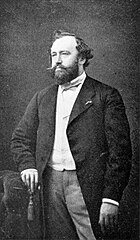The saxophone was developed in the 1840s by Adolphe Sax, a Belgian-born instrument-maker,flute player, and clarinetist working in Paris. While still working at his father's instrument shop in Brussels, Sax began developing an instrument which had the projection of a brass instrument with the mobility of a woodwind. Another priority was to create an instrument which, while similar to the clarinet, would overblow at the octave, unlike the clarinet, which rises in pitch by a twelfth when overblown; an instrument which overblew at the octave would have identical fingering for both registers.
Prior to his work on the saxophone, Sax made several improvements to the bass clarinet by improving its keywork and acoustics and extending its lower range. Sax was also a maker of the then-popular ophicleide, a large conical brass instrument in the bass register with keys similar to a woodwind instrument. His experience with these two instruments allowed him to develop the skills and technologies needed to make the first saxophones. Adolph Sax created an instrument with a single reed mouthpiece like a clarinet, conical brass body like an ophicleide, and the acoustic properties of the flute.
Having constructed saxophones in several sizes in the early 1840s, Sax applied for, and received, a 15-year patent for the instrument on June 28, 1846. The patent encompassed 14 versions of the fundamental design, split into two categories of seven instruments each and ranging from sopranino to contrabass. In the group Sax envisaged for orchestral work, the instruments transposed at either F or C, while the "military band" group included instruments alternating between E♭ and B♭. The orchestral soprano saxophone was the only instrument to sound at concert pitch. All the instruments were given an initial written range from the B below the treble staff to the F three ledger lines above it, giving each saxophone a range of two and a half octaves.
Adolphe Sax, the inventor of the saxophoneSax's patent expired in 1866; thereafter numerous saxophonists and instrument manufacturers implemented their own improvements to the design and keywork. The first substantial modification was by a French manufacturer who extended the bell slightly and added an extra key to extend the range downwards by one semitone to B♭. It is suspected that Sax himself may have attempted this modification. This extension was adopted into almost all modern designs.
Sax's original keywork was very simplistic and made playing some legato passages and wide intervals extremely difficult to finger, so numerous developers added extra keys and alternate fingerings to make chromatic playing less difficult. While the early saxophone had two separate octave vents to assist in the playing of the upper registers just as modern instruments do, players of Sax's original design had to operate these via two separate octave keys operated by the left thumb. A substantial advancement in saxophone keywork was the development of a method by which both tone holes are operated by a single octave key by the left thumb which is now universal on all modern saxophones. One of the most radical, however temporary, revision of saxophone keywork was made in the 1950s by M. Houvenaghel of Paris, who completely redeveloped the mechanics of the system to allow a number of notes (C♯, B, A, G, F and E♭) to be flattened by a semitone simply by lowering the right middle finger. This enables a chromatic scale to be played over two octaves simply by playing the diatonic scale combined with alternately raising and lowering this one digit. However, this keywork never gained much popularity, and is no longer in use.


2 comments:
aduh... what is it?
aduh... what is it?
Post a Comment